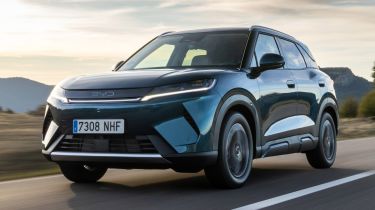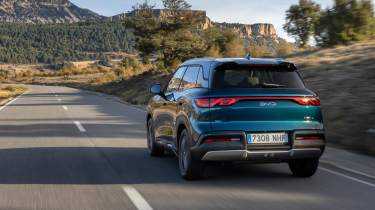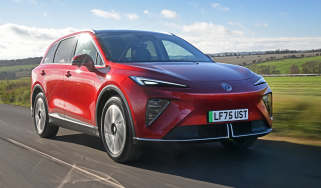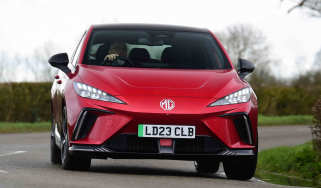New BYD Atto 2 DM-i 2026 review: hybrid SUV is better than its EV sibling
The new BYD Atto 2 DM-i is a plug-in hybrid SUV that covers all the basics, but rivals are better to drive

Verdict
While we weren’t massively convinced by the all-electric BYD Atto 2, the plug-in hybrid is far more appealing. It’s difficult to recommend the Active with its short EV range, but the bigger-battery Boost car will make sense for a lot of people – especially at its incredibly attractive predicted price point. It won’t have this part of the market to itself for long, but for now BYD’s onto a winner.
Plug-in hybrids have been the preserve of big executive-car buyers, but now BYD is looking to bring the technology to a whole new clientele. The electric Atto 2 has already landed in the UK, but lining up alongside it from spring next year will be a plug-in hybrid option – with the aim of “replacing all internal-combustion needs”, according to BYD.
The Atto 2’s technical make up results in some very promising numbers. There’s a 1.5-litre four-cylinder Atkinson petrol engine (like the Honda Civic’s) and it works in conjunction with a dual-motor (hence the ‘DM’ part of the name) layout – where one is responsible for generating power and the other sends drive straight to the front wheels. With an 18.3kWh battery (with the compact ‘Blade’ design that BYD puts in its fully fledged EVs), the Atto 2 DM-i can cover 55 miles on a single charge – more than a plug-in hybrid BMW X3.
The car we’re testing is the Boost trim, which gets a combined 209bhp for a 7.5-second 0-62mph sprint. An entry-level Active version with a less powerful motor, smaller battery and shorter 25-mile EV range is also available; with 164bhp that car takes 9.1 seconds to complete the benchmark sprint; both cars are limited to 110mph.
The Boost is slightly quicker to 62mph than the electric Atto 2, though in the real world, despite the different powertrains, they feel pretty similar. That’s because the Atto 2 DM-i prioritises its electric motor over the four-cylinder petrol engine, in a bid to provide a smoother drive with instant torque readily available; the electric motor produces 300Nm on its own. During our two-hour drive we never felt we needed the extra punch of the engine – with the flexibility of the electric motor’s punch extending well into motorway speeds.
It’s possible to override the BYD’s electric bias by selecting the ‘HEV/EV’ button on the centre console, or by cycling through the various driving modes (Sport, Eco, Normal, Snow) – each altering the drivetrain’s focus, albeit not by any noticeable amount. Like the EV, there are also two brake-regeneration settings: ‘Standard’ and ‘High’, though both are weak by European or Korean standards.
You have to mash the throttle very hard to cause the petrol engine to wake up, and harder still to create any noise from under the bonnet – though it’s not the most tuneful engine once it does burst into life. BYD pitches the Atto 2 DM-i as the car for those not quite ready for the full-EV, and the electric motor’s ability to do some serious heavy lifting makes it feel like a worthy stepping stone. After testing on a variety of roads, we found the DM-i’s electric range had gone down almost in line with the predicted trip figure. We’d expect most people would get close to its claimed electric range.
Because of its preference for electric running, the plug-in hybrid provides a similar level of refinement to the EV. It also means the DM-i suffers similar issues regarding the pronounced wind and road noise, though compared to other B-segment SUVs it’s not bad.
The same can’t be said of the ride. Because of the placement of the battery and the energy recovery unit just in front of the rear axle the DM-i gets a torsion beam at the rear – the same as the smaller-battery Atto 2 EV. We don’t think this helps the overall ride comfort, with the DM-i car often feeling fidgety at high speeds, while slumping into potholes around town.
This is in spite of the relatively small 17-inch wheels. With such deep tyre sidewalls, you’d expect it to soak up bumps better. The larger-battery, all-electric model gets a more sophisticated multi-link rear suspension and we experienced a slightly smoother ride in that car.
Like the electric Atto 2, the PHEV isn’t one for chucking into bends. It’ll cling on just fine, and the braking force is sufficient, but vague steering doesn’t inspire much confidence on twisty roads.
BYD has played it safe with the styling of the Atto 2 – unlike the Atto 3 with its bizarre guitar-string door pockets – both inside and out. Jump in and you’ll find the dash dominated by a fixed 12.8-inch touchscreen (it doesn’t rotate like in other BYDs), and an 8.8-inch driver’s display. Working like most smartphones, the infotainment layout itself is pretty easy to get your head around. A simple swipe down brings up a selection of customisable tabs like brightness, Wi-Fi, bluetooth and heated seats. It also means you can quickly turn off things like the overly intrusive lane-keep assist.
The responsiveness of the infotainment is excellent and during our drive we found it easy to operate whilst driving. The lack of physical climate controls is annoying, especially when BYD admitted receiving customer feedback requesting buttons for frequently-used controls. The few buttons there are all feel solid enough, however.
In fact, overall interior build quality impressed us. We experienced no squeaks or rattles during our drive, and most surfaces seemed up to the task of dealing with family life. We did find the difference of door materials in the front to the rear slightly odd – you’ll find more scratchy plastic in the back, for example – and the fake, moulded stitching was strange, too.
It’s spacious inside the Atto 2. The upright SUV profile means headroom is excellent front and rear, and a pair of six-footers will be fine in the back for long journeys. The boot is 25 litres larger than the EV’s at 425 litres, though the back seats don’t fold completely flat.
The standard kit list is pretty good. The base Active gets a rear-view camera with parking sensors, rain-sensing wipers, adaptive cruise control, LED headlights and metallic paint – though the colours are pretty limited. Boost brings a 360-degree camera, heated front seats, a heated steering wheel, tinted windows, a panoramic roof and wireless smartphone charging. You can even make use of the Boost’s bigger battery with vehicle-to-load (V2L) tech, capable of powering external appliances.
BYD hasn’t revealed UK pricing for the Atto 2 DM-i, though we’ve been told it’ll start from around £25,000 for the smaller-battery Active, and £28,000 for the Boost. That would make the Atto 2 DM-i the UK’s cheapest plug-in hybrid, undercutting the larger Chery Tiggo 7 by a couple of thousand pounds.
Did you know you can sell your car through Auto Express? We’ll help you get a great price and find a great deal on a new car, too.
| Model: | BYD Atto 2 DM-i Boost |
| Price: | £28,000 (est) |
| Powertrain: | 1.5-litre four-cylinder petrol + 1x e-motor |
| Power: | 209bhp |
| Transmission: | Single-speed automatic, front-wheel drive |
| 0-62mph: | 7.5 seconds |
| Top speed: | 110mph |
| Economy/emissions: | 130mpg/45g/km |
| Size (L/W/H): | 4,330/1,830/1,675mm |
| On sale: | Spring 2026 |









